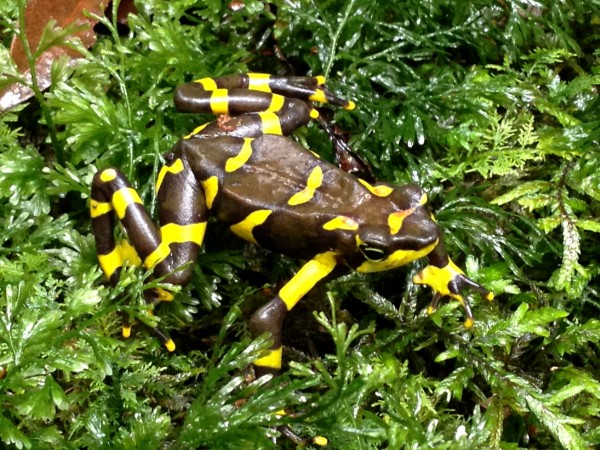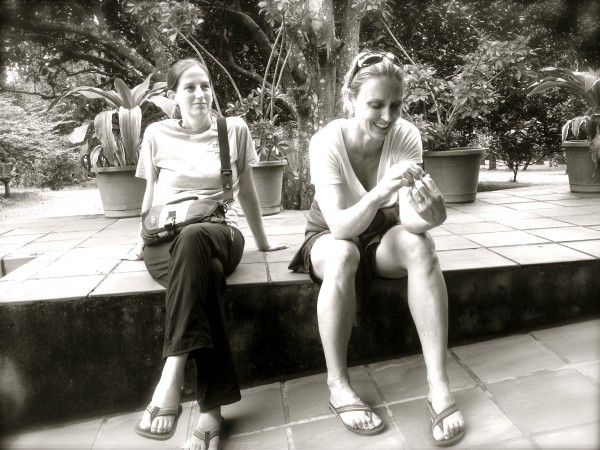
There are two types of golden frogs in Panama. This one, Atelopus varius is the variable harlequin frog, which ranges in appearance from from this browner form to a bright yellow color at some sites. Atelopus zeteki is the distinctive day-glow yellow Panamanian golden frog. Photo: Jamie Voyles, Project Atelopus
Jamie Voyles
One small frog can offer a great deal of hope. This frog, an adult male Atelopus varius, belongs to a genus that is critically endangered – not a single species, but the entire genus – and it is, therefore, one of the most rare creatures on earth. The Panamanian golden frog Atelopus zeteki carries the additional distinction of being Panama’s national animal and it is a symbol of good luck for the Panamanian people – so much so, that in the past golden frogs graced the face of lottery tickets. So, the loss of Atelopus, due to the lethal disease chytridiomycosis, has been nothing short of a tragedy for Panamanians, as well as for the larger global community.
About a decade ago, together with my colleague, Cori Richards (now Dr. Cori Richards-Zawacki), and I watched these golden jewels vanish from the streams of Panama as the disease chytridiomycosis (“chytrid”) spread across the country. Cori and I were still graduate students; we had a youthful (albeit slightly naïve) enthusiasm for confronting the ominous conservation disaster. Cori focused on golden frogs for her PhD and sampled thousands of frogs before they succumbed to disease. I was interested in understanding which species would be affected by the disease, not knowing that chytrid would, in a few short years, cause a wholesale wipe-out of entire amphibian communities. When frogs started to disappear, our research projects ground to a halt. After all, no frogs means no frog research. So our advisers, perhaps wisely, advised us to move on. As we shifted our research projects to other locales, the golden frogs reached the brink of extinction; sightings of these now-rare creatures dwindled until they were mere rumors.
Fast-forward ten years. Cori and I had both advanced in our academic careers, but we were still haunted by the loss of Panamanian amphibians. When Cori visited the University of California, Berkeley, where I was finishing up my post-doctoral work, we spent an afternoon sitting on the green campus lawn and reflecting on our work of a decade earlier; despite the projections, we had not realized the full scope of what had been coming – especially for those beautiful Panamanian frogs. In those days, we remembered, not very many people outside of a small group of researchers had even heard the word “chytrid”, much less tried to pronounce it. Few were paying attention to the global decline of amphibian populations; even fewer were aware of Panama’s devastating loss of its national mascot and lucky charm. So, naturally, we hatched a plan to return. We needed to see for ourselves what remained of the Panama’s golden frogs.
We set about gathering money from conservation grants, one small award at a time. The news coming from field reports was grim, but we remained determined. We pooled our small pots of funds (including support from the Smithsonian and Project Golden Frog) and galvanized small research team (including Edgardo Griffiths, Heidi Ross and Matt Robak). Soon enough, we trudged the misty mountains of Panama, machetes in hand and hopes held high despite the overwhelming odds. We visited numerous sites where Atelopus varius and Atelopus zeteki were historically found, including all of Cori’s old golden frog sites. We followed rumors, tips and hints. After several months of surveys, after hours of climbing trails with heavy packs and muddy boots, we repeatedly stumbled out of the rainforest disappointed, bug-bitten and empty handed. It would have been easy to admit that we weren’t chasing frogs anymore – now we were chasing ghosts.
Until, after months of searching, we finally found our glimmer of hope. On November 8, 2012 we found a healthy adult male Atelopus perched on a mossy boulder, unconcerned that a cross-continent scramble had been underway for months, just to find him. We sat in the rain, watching him and snapping pictures. We collected non-invasive samples for diagnostic and genetic testing and then, somewhat reluctantly, we said good-bye and wished him well. We were overjoyed…. and here’s why: One small frog in the wild suggests that there are at least some surviving populations out there. And if there is even one small population holding on, there is hope – not just for that population, or even for the species, but for the whole genus. Having evidence to support that hope, in the form of that single, small and beautiful frog, is something even better than holding a winning lottery ticket with his picture on it.
To find out more about Project Atelopus follow their field blog here.

